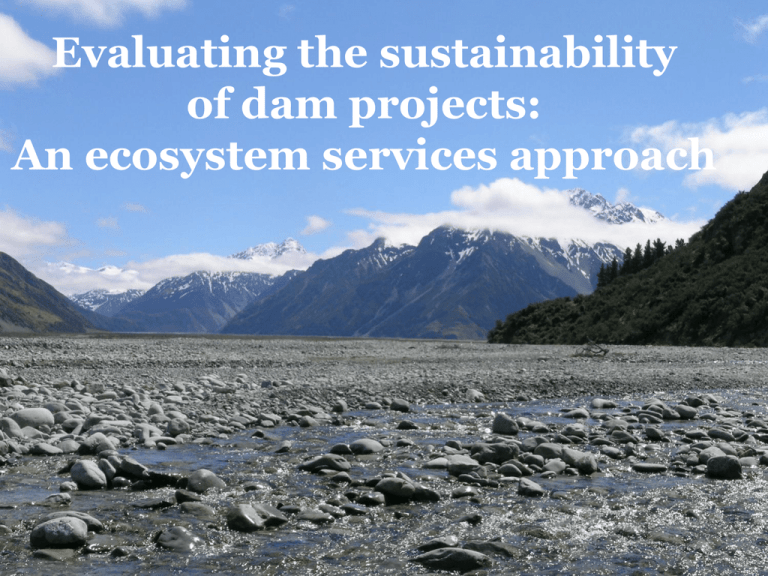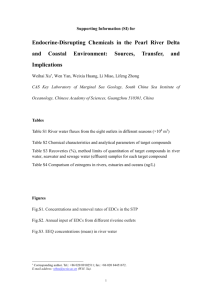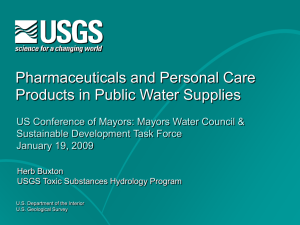Evaluating the sustainability of dam projects: An ecosystem services approach
advertisement

Evaluating the sustainability of dam projects: An ecosystem services approach Case study: Monitoring the performance of a dam Increasing demand for water abstraction Declining health of river ecology & loss of river values Solution: The Opuha dam in 1997 Demand to evaluate its sustainability An ecosystem services approach is proposed The ecosystem services approach Step 1: Ecosystem services (ES) are identified Step 2: Stakeholder representatives preferentially weight each ecosystem service. Step 3: Indicators which represent each ecosystem service are collated. Step 4: The preferential weights and indicator scores of each service are incorporated into a multi-criteria analysis which will produce the ESI. Monitored over time the ESI can indicate sustainability Potentially... the cost-effectiveness of a storage option could then be ascertained by considering this ESI alongside project costs. Biophysical Biophysical Socio-Economic Indicator A Indicator B Indicator A Sp irit ual Va lue s Ae sth eti c Va lue s Recreational Values Ed uc ati on al Va lue s Aesthetic Values Co ns erv ati on Va lue s Conservation Values Er osi on Co ntr ol Erosion Control Pe st Re gu lat io n Pest Regulation Di sea se Re gu lat io n Disease Regulation W ate r Pu rifi cat io n Water Purification Na tur al Ha zar d Re gu lat io n Natural Hazard Regulation W ate r Re gu lat io n Classes are preferentially weighted by stakeholders Cultural Ecosystem Services Spiritual Values Regulating Ecosystem Services Water Regulation Ab iot ic Pr od uct s Abiotic Products Fi br e Fibre Freshwater Supply Food Provisioning Ecosystem Services Educational Values ESI = ∑wnsn Fre sh wa ter Su pp ly The ESI is monitored over time. An increasing index value indicates ‘weak’ sustainability (or a movement towards it) Ecosystem Services Index ES are also preferentially weighted by stakeholders (w) Expertly verified indicators monitor the state of each ES (normalised scores are aggregated). (s) Safe minimum standards allow strong sustainability to be monitored. Opuha dam Opihi river Step 1: Ecosystem services of the river are identified 15 ES are identified for the Opihi River Class of ES Ecosystem service Abiotic Products Biological Products Fibre Provisioning Food Water Supply Climate Regulation Disease Regulation Erosion Control Natural Hazard Regulation Regulating Pest Regulation Water Purification Water Regulation Aesthetic Values Conservation Values Cultural Educational Values Recreational Values Spiritual Values Examples of ecosystem service Gravel extraction for road chip and concrete Not applicable Flax, driftwood Game fisheries (e.g. salmon, trout), native fisheries (e.g. eel, whitebait, flounder) Irrigation, hydroelectric production, municipal water use, industrial water use, stock water use Not applicable Parasite and toxic algae regulation Stabilization of river banks Flood and drought protection Invasive non-native species (e.g. Algae) Removal of pollutants River flow regulation (e.g. minimum river flows) Perceived beauty Endangered native species (e.g. black-billed gull), significant landscapes (e.g. Opihi Lagoon) Historical/archaeological values & knowledge systems Sailing, rowing, kayaking, fishing, duck hunting, picnicking, swimming, walking Māori values (e.g. mauri) Step 2: Stakeholder preferences A one-to-nine scale was used, where one represents Weak preference Indifference Weak preference Medium preference Strong preference Overwhelming preference Food Medium preference Provisioning Ecosystem Service Overwhelming preference preference Strong neutrality or indifference between the pairing and nine represents an overwhelming preference for one ES over the other. 9 5 3 1 3 5 7 9 7 Provisioning Ecosystem Service Abiotic Products Bi bi o ol tic og Pr i c od al Pr uct od s uc ts Fi br e Cl W im ate Fo r S od a D te is Re up ea p N se gul ly at R at ur al Ero egu ion H si az on lati o ar d Co n R n Pe eg tro W st R ula l ti at er egu on W Pu lati at rif on er ic A Re atio Co est gu n ns he lat er tic io Ed va Va n uc tion lu Re ati V es o a cr ea nal lues tio Va Sp nal lue iri V s tu alu al e V s al ue s A Preferential Weights 0.12 Regional Preferences Local Preferences 0.10 0.08 0.06 0.04 0.02 0.00 Step 3: Expertly verified indicators which represent each ecosystem service are collated and their safe minimum standards recorded. -The evaluation period was 1989 to 2008. -(Dam construction 1997) An example using the provisioning class of ecosystem services... *Light blue sections reflect available indicators. Class Ecosystem service Abiotic Products Environmental indicators Socio-economic indicators Mean River Bed Level (m) Profitability of Gravel Resource ($) Volume of Gravel Extracted (m3) Number of Fibrous Species Fibre Provisioning ecosystem services Food Number of People Actively Collecting Fibrous Materials Total Biomass of Fibrous Species (kg) Annual Periphyton Cover (%) Commercial Fishery Employment Average Weight of Fish Caught (kg) Cultural Health Index Benthic Community Metabolism (R2) Fish Taste Biochemical Oxygen Demand (mg/l) Number of People Actively Collecting Food Days River Mouth Closed Dissolved Oxygen Level (ml/l) Number of Mahinga Kai Species Number of Salmonids Caught pH Level Presence of Riparian Vegetation Spawning Numbers Turbidity (NTU) Water Temperature (0C) Irrigated Area (ha) Water Supply River Flow Variability (σ2) Total Volume of Water Takes (m3) Economic Impact from Irrigation ($) Double counting Indicator E. coli Level Irrigated Area Minimum River Flows Number of Flood Flows Qualitative Macroinvertebrate Community Index pH Level Communicability Ecosystem service (1-9 scale) Recreational Values 6.3 Water Purification Water Supply Natural Hazard Regulation Water Regulation 7 8 Recreational Values 5 3 Data availability (1-9 scale) Annual cost (1-9 scale) 7.67 5 6.33 Conservation Values 7 Water Purification Water Purification Food 6.33 7 5 9 2.79 2.93 8.5 9 2 5 Natural Hazard Regulation Water Regulation Indicator costeffectiveness 6 4 7 3 8.33 4.33 4 4 3.39 7 7 6.33 3 2.21 2.11 4.67 4 Step 4: Using the ESI to evaluate for weak sustainability ESI = ∑wnsn ESI / # indicators in that year Pre-dam Pre-dam Ecosystem Services Index 2.0 Post-dam 2.5 Post-dam 1.5 1.0 0.5 Local Preferences Regional Preferences Long-term Trend 0.0 1985 1990 1995 2000 2005 2010 Key findings of case study Fifteen ES were identified from the river Since dam construction the river has progressed towards both weak and strong sustainability in its provision of ES. (Interpretation of this finding needs to acknowledge the state of the river pre-dam) There exists a need to develop a standardised set of effective indicators of river ES -Alternatively ES could be decomposed into more tangible benefits, allowing improved correlation with indicators. Thank you Safe minimum standards Ecosystem Service Indicator Safe Minimum Standard Threshold Source Abiotic Products Mean River Bed Level 40.93m Boyle & Surman, 2007 Fibre Number of Fibrous Species No decline Expert Biochemical Oxygen Demand Maximum 1mg/l Expert Dissolved Oxygen Levels Daily minimum 8ml/l Expert Number of Salmonids Caught 500 caught Expert Spawning Numbers No undesirable trend Expert Water Temperature Daily minimum 4C & maximum 20C ECan, 2010; Expert Economic Impact from Irrigation No decline CMF, 2010 River Flow Variability No increase CMF, 2010 Total Volume of Water Takes No undesirable trend CMF, 2010 Food Water Supply An Evaluation for strong sustainability Percentage of Years Failed Opihi River Ecosystem Service Pre-dam Post-dam Abiotic Products 0 0 Fibre 0 0 Food 3.3 37.5 20.5 0 Disease Regulation 0 18.2 Erosion Control 50 36.4 11.1 0 0 0 Water Purification 27.3 26.7 Water Regulation 69.6 18.2 Aesthetic Values 50 54.5 Conservation Values 3.3 2.6 Educational Values 0 0 Recreational Values 41.7 33.3 0 0 19.6 14.0 Water Supply Natural Hazard Regulation Pest Regulation Spiritual Values Total Percentage of Years Failed SMS 0 Supp ly Dise ase R egul ation Eros ion C ontro l Natu ral H azar d Re Wate gula tion r Pur ificat ion Wate r Reg ulati on Aest hetic Valu es Cons erva tion Valu Recr es eatio nal V alues Wate r Food The sustainability ‘gap’ -10 -20 -30 -40 -50 -60 Degree of Degradation Pre-dam Post-dam

